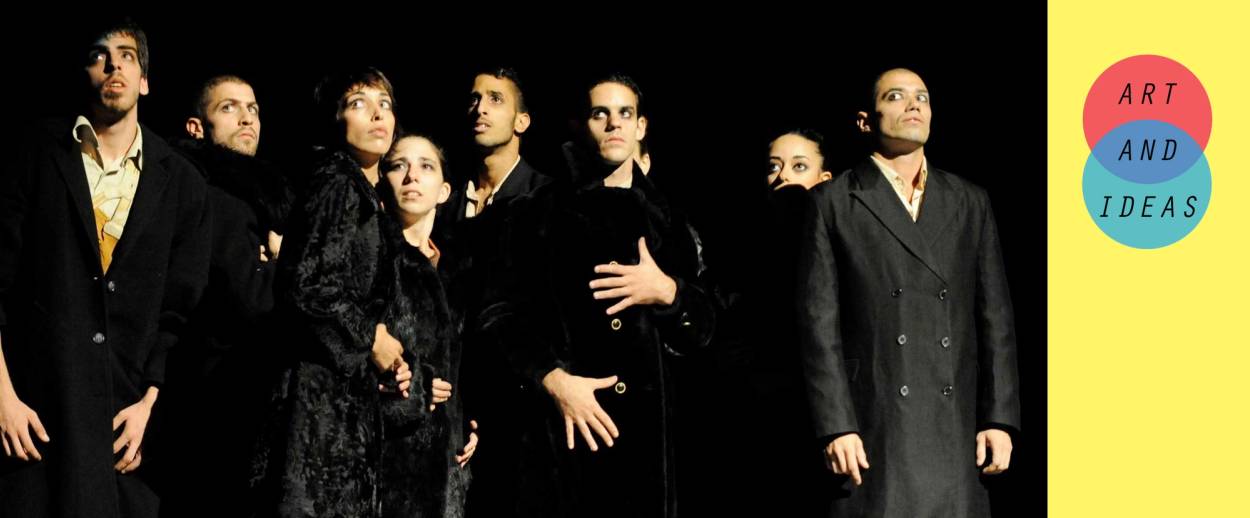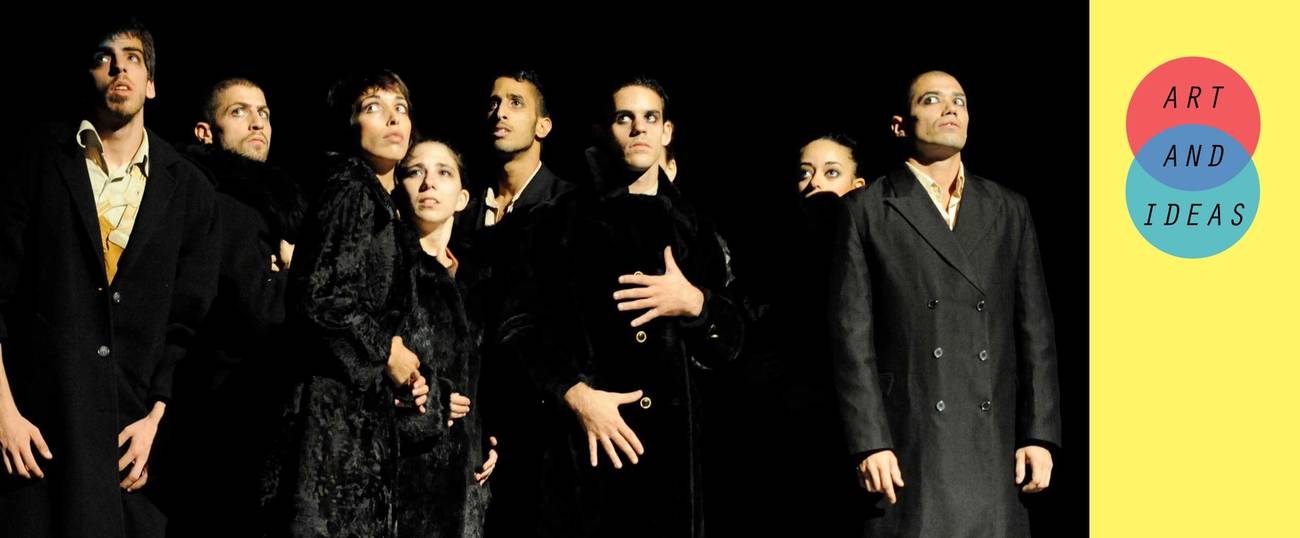If the shtetl characters in a Chagall painting jumped into a time machine and transported themselves to a Jerusalem shuk, they would fit perfectly into Monger by the brilliant Israeli choreographer Barak Marshall. “Dance in Israel often reflects the cultural interest to shy away from history and only reflect the nature of the ‘New Jew,’” Marshall told me. “I reject this completely—I mine the richness of my Jewish culture in my work, embrace its complexity, and hide nothing.”
With a mop of wild curly black hair, Marshall has a warm, mad-scientist demeanor. He is dance royalty, the son of Margalit Oved, Israel’s Yemenite prima ballerina of the historic Inbal Dance Theater. She moved to Los Angeles in 1967 and started a family after meeting Marshall’s Bronx-born father, Melvin. Soon she founded her own dance company, Margalit Oved Dance Theatre, and was on the dance faculty at UCLA.
After a childhood of sleeping on rehearsal floors and touring internationally with his mother, Marshall chose not to train in dance. He instead studied music and theater in his youth and received his bachelor’s degree in social studies from Harvard.
One of the unique elements of Marshall’s style is his masterful use of gesture. In Monger, the choreography is full-bodied and replete with slides to the floor and grand jeté leaps. The dancers communicate their strongest moments in powerful gesticulations. Marshall choreographs full sections of movement focusing on sole articulations of the hands, arms, and shoulders, which has the effect of a conversation distilled.
“I think it is genetic,” laughed Marshall. “My family is from Aden in Yemen. I grew up talking with my hands. A sentence of movement is a sentence of meaning. My work is like a full-body sign language.”
Almost a decade after its Tel Aviv premiere in 2008, Monger will be performed in Los Angeles starting tonight through Nov. 19, at the Glorya Kaufman School of Dance at the University of Southern California. The work draws equally from the short stories of Polish-Jewish writer Bruno Schultz and Marshall’s mother’s experiences cleaning houses for wealthy Ashkenazi families when she first arrived in Israel in 1949. The costumes are peasant-like, with earth-tone head-scarves and dresses for the women and work shirts, vests, and suspenders for the men. Although the piece adheres to a chronological order, much of the action in Monger unfolds like a surrealistic dream set to a vivacious mélange of Klezmer, Jewish folk songs, and percussive Middle Eastern beats.
“His work reveals deep emotion—anger, humor, and love,” said Yoav Grinberg, a longtime dancer with Marshall. “It is very Jewish—scenes from weddings, gefilte-fish commercials, and marching of Israeli soldiers. But it successfully remains a cultural study without spouting a political agenda.”
All of Marshall’s works take inspiration from literature or history. Monger is an allegory similar to Gosford Park; Roosteris an ode to I.L. Peretz’s Yiddish tale “Bontsha the Silent”; and The Castaways alludes to The Lord of the Flies. Long interludes of choreography are interrupted by dialogue and dramatic scenes.
“My pieces are really more like plays,” said Marshall. “There are characters, plots, and action; a climax and denouement. It is not just movement for movement’s sake.”
‘A sentence of movement is a sentence of meaning. My work is like a full-body sign language.’
Marshall’s first foray into choreography was as fable-like as the plots of his pieces. Struck by the sudden death of his Aunt Leah, he dealt with his grief in a physical manner. He locked himself in a dance studio and tried to remember his aunt’s sayings, movements, and mannerisms. A colleague of his mother’s watched this ritual grief through a window and told him he must make it into a dance piece. The result was Aunt Leah, which premiered in 1995, and was awarded first prize at Israel’s prestigious Shades of Dance choreography competition.
In the late 1990s, a range of new Israeli voices emerged onto the contemporary-dance scene, and Marshall made one of the strongest impressions. He was appointed as the first in-house choreographer of the renowned Batsheva Dance Company in 1999. Samuel Wuersten, director of the Holland Dance Festival, first saw Barak’s choreography during this time. “It was really distinct, dynamic, and a beautiful display of ethnic folklore,” said Wuersten in a phone interview. “The narrative element really stood out, and the detailing showed it was the creation of someone with a truly broad education.”
With the stamina of an academic researching a dissertation, Marshall takes months to prepare each piece of choreography. He listens to tens of thousands of tracks of music, creates a libretto, and maps out all songs and movement on a storyboard. He always works with a narrative and intentionally shies away from the kind of abstract work that has become prevalent in Israel. “The audience is intelligent, and it is great to communicate with them directly. I don’t aim to make work they intentionally can’t understand,” said Marshall.
In his more recent works, Marshall has been particularly drawn to power dynamics and the role of the underdog. A piece he created for Inbal Dance Theater,1972, celebrates a Mizrahi nightclub in Shkhunat Hatikva, a southern Tel Aviv neighborhood. Set to Mizrahi and Arabic music and with a cast of performers clad in polyester disco dress, 1972 examines this oppressed class of Israeli society in their moments of celebration and escape. The piece also features transvestites, who in 1970s Israel were often Mizrahi Jews—at the time low on the totem pole in a country plagued by issues related to race, sexuality, and class.
Marshall maintains a dual status as both an insider and observer. With no official dance training, he brings a fresh take to the possibilities of choreographic creation, and his works have an unsurpassed originality. On a personal level, his upbringing outside of Israel has given Marshall a unique perspective on his heritage, especially its Yemenite side. “I always found it interesting, the different ways my Mizrahi culture was viewed. I grew up L.A. in the 1970s and it was all about multiculturalism. I was super-proud to be Adenite and felt huge support from my community,” revealed Marshall. “However, in Israel, it was the total opposite. There are and continue to be major prejudices toward Mizrahi Jews. It still shocks me. There is so much more work to do.”
Not long after his appointment at the Batsheva company, Marshall was hit by a car and was forced to take an eight-year hiatus. Monger in 2008 was his return to choreography. Since then he has created a steady body of work for companies all around the globe. Monger continues to be hugely popular, and new stagings of the piece will be set this year in Europe. He is thrilled to be creating a new piece for the Suzanne Dellal Centre in Tel Aviv in the fall of 2018. While he has been recognized internationally for nearly two decades, Marshall feels like he is just beginning his choreographic research.
Read more from Tablet’s Art & Ideas Week here.

